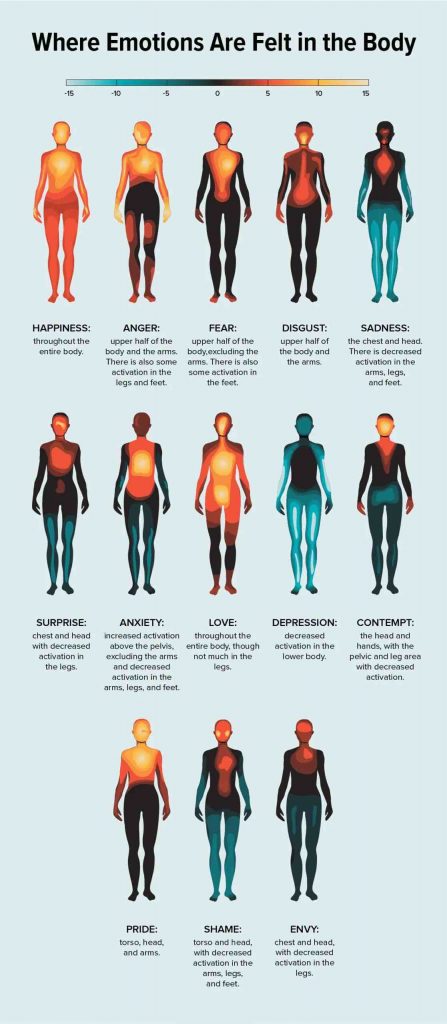Emotions like anger, sadness, hurt, fear, and shame can be challenging and overwhelming. They can consume our whole being, weigh us down, and disrupt our lives.
Many people bottle emotions up. Or deny themselves from feeling them. They distract themselves with alcohol, drugs, excessive exercise, or overworking. Others will watch TV, scroll on their phone, play video games, go shopping, eat, or even pursue sex.
Have you noticed doing this yourself? Maybe that’s why you’re here reading. If that’s the case, don’t feel bad. This is a common way to deal with emotions.
The problem is when you suppress or avoid feeling powerful emotions, they’re stored in your body. They stay there unreleased. Overtime they feel heavy and weigh you down. Not only can this impact your physical and mental health, they’ll build up and release.
They’ll come crashing down like immense waves.
You can avoid this happening by releasing them safety, gradually, and with compassion. How? That’s exactly what I’ll answer in this article. First though, let’s look at how and where we store emotions in the body.
How Do Emotions Get Stored in Your Body?

Our bodies and minds are connected. We all have a nervous system that connects our brain to other parts of the body, including our vital organs. The brain and body work to send information back and forth to each other via a system of nerves.
When you feel afraid or threatened, your mind sends signals to prepare your body. As this happens, your heart and breathing rate increase. More blood flows to your organs and muscles, whilst you release adrenaline.
You’ve activated your fight-flight-or-freeze response, causing you to feel alert and ready.
So, stress can manifest in physical ways. This happens with other emotions too. Especially when you ruminate about the past, get frustrated with the present, or worry about the future
If you do this all the time without releasing your emotions in a healthy way, your body will react and store them.
Some believe this emotional energy gets stuck in the body, vibrating at its own frequency. Cultures who practice Hinduism and Buddhism call these areas chakras. To release them they practice specific types of yoga and meditation.
It’s hard to prove this scientifically, but it makes sense. What do you think?
There are also fascinating stories about people who received organ transplants. Afterwards they developed personality changes, new tastes, and memories related to their donor. Bizarre!
It seems that there is a lot more going on than we currently understand. Who knows what we’ll discover in the future.
Where Do You Store Emotions in the body?

The image above if from a study done in 2014 by scientist Enrico Glerean and his colleagues. They asked 701 participants to colour in where they felt emotions on a body silhouette. As they observed evoking images, videos, conversations, and facial expressions.
You may find it helpful to reference this image to bring awareness to where you feel emotions. But don’t worry if it doesn’t match up exactly. We are all unique and can have a different experience from others. This study helps to bring light to how areas of tension occur due to repeated exposure to stress.
If you’re suffering from aches, pains, and headaches. Or experiencing fatigue and insomnia, trapped emotions may be contributing.
Or they might have played a part in leading to these physical impairments and illnesses. It’s always best to speak to your doctor first though.
“The long-term pain suffered by suppressing emotions is far greater than the short-term pain of confronting them.”
— Sam Owen
My Own Experience with Suppressed Emotion

In my early twenties I was suffering from extreme depression and acute anxiety. I had low self-esteem, no confidence, and was causing myself a lot of angst.
I was very young at the time and didn’t have the self-awareness or tools to manage my body and mind.
It wasn’t until a year later that I saw a therapist. He helped me to release the emotional baggage I had been carrying for so long.
Overtime, I began to feel lighter. I was no longer weighed down with the burden of heavy emotion. I’m telling you this to give you hope. There are ways to prevent this from happening in the first place.
Let’s look at how.
“Your mind, emotions and body are instruments… the way you align and tune them determines how well you play life.”
— Harbhajan Singh Yogi
How Do You Release Stored Body Emotions?

Talk to a Therapist
Learning to explore and release stored trauma can be distressing. It may bring up troubling and delicate things from your past. It could be overwhelming or damaging to do this by yourself.
It’s not always easy to find the right therapist. Find one who has experience working with the body, trauma, and compassion. They should be able to approach this process with caution. As they guide and support you through it safety.
Finding an experienced, ethical, caring, and supportive therapist is always a good option. Especially if you are carrying emotion from past traumatic experiences. However, if you think you can manage the trapped emotions by yourself, let’s look at some other methods.
Practice Mindfulness Meditation
Mindfulness meditation teaches you to become more aware of your mind and body. This includes your thoughts, emotions, and feelings. There are two practices that work with the body in particular.
- The body scan
- RAIN practice
In the body scan you focus on individual parts of your body one at a time. You pay attention to sensations such as tingling, aches, pains, discomfort, pressure, and temperature.
In the body scan you focus on individual parts of your body one at a time. You pay attention sensations such as tingling, aches, pains, discomfort, pressure, and temperature.
By doing so you become more in tune with your body and learn to identify areas that may need some extra attention. Over time you’ll begin to recognise emotions occurring quicker. Even as you go about your day-to-day business.
This empowers you to be in control of your emotions, as opposed to acting out of impulse.
When you’re facing challenging emotions such as anger, anxiety, or sadness, try the RAIN practice. Involving the following steps:
- Recognise what is happening. You begin to bring awareness to the difficult emotion.
- Allow the experience to be there fully, instead of ignoring or denying it.
- Investigate it with interest, attention, and compassion. This involves pinpointing where you’re feeling it. Then explore it deeply. Notice all the sensations it brings, whilst cultivating loving kindness towards yourself.
- Non-identify. When we’re overwhelmed with an emotion it can feel all-encompassing. Like it’s taken over our whole being completely. In the final stage, you learn to get some distance and space from the emotion, recognising you are a whole person. This difficult emotion is just a tiny part of your experience in this moment, it will pass.
This is a mediation I always go back to whenever I’m struggling with difficult emotions. I’d recommended giving it a go the next time you’re feeling overwhelmed with emotion. What do you have to lose?
Use Yoga to Heal Your Body
In the west, many people treat yoga as a workout. A way to increase strength and flexibility. But it’s more of a spiritual practice at heart.
Other cultures use yoga in a similar way to mediation. To train the body and mind. Cultivate self-awareness, obtain higher consciousness, and increase focus. All whilst learning to observe one’s own thoughts, feelings, and emotions.
Yoga is all about posture, movements, and poses. This involves releasing areas of tension within the body. Some of which could be caused by trapped emotions. I’m no yoga expert, but I always feel very relaxed and at peace after attending a class.
Why not to find a yoga studio that focusses on this? Give it a go.
Try Progressive Muscle Relaxation
Progressive muscle relaxation (PMR) is similar to the body. You still bring focus and attention to individual parts of the body, but there is a difference. During PMR you tense and tighten your muscle groups one by one, and then release and relax them.
Making it effective for relieving your stored body tension.
Many therapists use PMR to treat stress, anxiety, and insomnia. Especially as it promotes rest and relaxation. It’s a simple exercise you can do at home. You should be able to find plenty of free audio guides on YouTube and other websites.
Somatic Experience May Give You Further Insights
Somatic Experience is an alternative form of therapy. It’s used to treat trauma, anxiety, grief, PTSD, chronic pain, and substance abuse disorders by releasing stress from the body.
Most therapeutic treatments begin by focusing on a someone’s thoughts first. But SM therapists start by bringing awareness to sensations happening within the body.
As you do, they may ask you what’s arising. They’ll observe your behaviour and body language to pinpoint the areas storing tension. The therapist may also use guided imagery to evoke certain feelings.
SM uses breathing and relaxation techniques, movement, posture changes, and talking.
If you want to try Somatic Experience, check out directory.traumahealing.org to find an accredited therapist.
Release Your Emotions in Other Ways
I’m a musician so I find creating, playing, and listening to music to be a healthy outlet for me. Not big on music? You could also write a poem, paint, or draw. Additionally, try speaking into an audio recorder to verbalise and validate your feelings. Journaling works in the same way.
The important thing here is to do something that helps you to be aware of your emotions. Once they appear, don’t just keep doing the task, explore your body like in the RAIN practice. Go into the emotions fully.
Welcome and feel them completely. Explore with curiosity, and be kind to yourself. You’re human. It’s normal to be experiencing and feeling these sensations.
It Takes Courage to Face Your Emotions
Coming face-to-face with your emotions head on is challenging. That’s why most people avoid them. But doing so can have devastating long-term consequences for your well-being.
By learning to release your emotions in a heathy way, you’re taking positive action. You’re choosing a mindful way to be. Why not try one of the methods above and see if it works for you? If it doesn’t, move on to another.
I’d like to conclude by emphasising the importance of compassion. If you start releasing difficult emotions from your body, be compassionate towards yourself. You can say simple phrases like ‘this is a moment of suffering, it’s ok to feel these emotions’. Or ‘may I be well’, ‘may I be happy’.
Have you ever noticed pain arising in your body due to life stresses?
Take care of yourselves,
Chris from Mindful Way to Be


